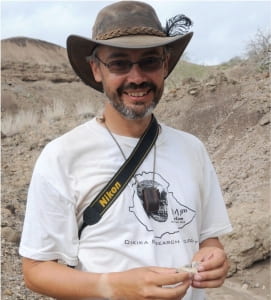Fossilized teeth can tell a story of the diets of long-gone animals and in turn shed light on the environments in which the animals lived. In a pair of recent articles, Enquye Negash, Zeresenay Alemseged, Jonathan Wynn, and colleagues report that carbon isotope data reveal that the diets of herbivores and early hominin species in southwestern Ethiopia shifted toward grasses and sedges between 2 and 3 million years ago (1, 2). The University of Chicago paleoanthropologist Alemseged, who has studied the evolution of hominins in southwestern Ethiopia, returned to studying fossilized teeth with new analytical methods. Negash, a postdoctoral researcher at George Washington University, led the study that focused on the diet of nine different herbivore families, revealing that herbivores show two distinct shifts to increased grass consumption. Wynn, a geologist and program director at the National Science Foundation who led the hominin work, found only one such shift in hominins, around 2.37 million years ago.

PNAS: What can an animal’s diet reveal about its environment and evolution?
Negash: Whether it is feeding on grass, fruits, or leaves, herbivores feed on plants that are available on the landscape they live in. Studying their diet gives us information about their ecology and environment. The same principle applies to reconstructing the environment and understanding the evolution of herbivores in the fossil record. When studying a fossil herbivore assemblage, a grazer-dominated assemblage indicates an open landscape dominated by grasslands, while one dominated by browsers implies a more wooded landscape. Determining their diet and how it changed through time allows us to better understand how their environment changed.
PNAS: The fossils of the herbivores and hominins you studied are from the Shungura and Usno Formations in southwestern Ethiopia. How is the landscape different from that of millions of years ago?
Negash: The Shungura Formation is a site that covers the time span between 3.6 and 1 million years ago. During this time, what we’re inferring from our study is that there was a major shift in the vegetation on the landscape. Beginning around 3.6 to 2.9 million years ago, the landscape was dominated by more wooded environments. But from about 2.7 to 2 million years ago, there was an expansion of grasslands. Essentially, the landscape was becoming more open and dominated by grassland with time, which is very different from what we observe on the landscape today.

Alemseged: If you were to go today to the site where our fossil samples come from, you would see a mostly barren, hot, and dry landscape with acacia trees sparsely distributed and a gallery forest along a major river. If, instead, you invented a time machine and traveled back, say to 2 million to 4 million years ago, the conditions would be much more lush than what you see today. You would have a major river, which we call the proto Omo, surrounded by gallery forests and woodland and also a major lake. At some distance from the river, you would have more grassland environments within which you would see hundreds of wild animals roaming the landscape. Within this mosaic environment were the hominins: that is, our ancestors, who were the minorities sharing the landscape.
PNAS: Both studies relied on fossilized teeth collected previously in the Lower Omo Valley and housed at the National Museum of Ethiopia. However, you weren’t looking at morphology or wear patterns, so why teeth?

Wynn: The ancient river system that’s coming down from the Ethiopian Highlands feeds into Lake Turkana, bringing down lots of sediments and preserving all of these fossils without the sort of gaps in the sedimentary record that we have further south in the lake. The disadvantage is [that] this river system tends to break up a lot of the fossils before they get preserved. Most of the bones get broken up, but the teeth are much more dense, and they just don’t break down when they’re being transported by a river system. So, you’ve got tons and tons of fossil teeth, and they’re abraded but they are preserved very well. Because they’re often somewhat fractured, the museum is more likely to give permission to sample. We spent a lot of time combing through the database and combing through the collections to pick out the specimens that we wanted to sample. That was actually a fair amount of the work: Just identifying what would make the most systematic and representative sample of this very large dataset.
Alemseged: When I did my PhD two decades ago, I did not have access to fossil dental enamel powder. Our current isotopic work is exciting because it allows me to evaluate my earlier work (3) based on new evidence. What this research also reveals is that in order to make important discoveries in human evolution, you don’t always need more fossils, although fieldwork remains our primary source of data. By applying novel techniques and approaches on existing fossils—one of which is stable isotope analysis—one can answer some of the most prominent questions in paleoanthropology. What did our ancestors eat and how did they use their landscape?
PNAS: A small amount of dental enamel was removed for stable carbon isotope analysis. What were you looking for?
Negash: Dental enamel is composed of an inorganic compound that contains carbon derived from food. For herbivores, the carbon isotopic composition of the plants they eat—whether it is C3 plants, which are trees and shrubs, or C4 plants, which are grasses—is recorded in bones and dental enamel. So when we drill the teeth of fossil herbivores and remove a small amount of powder enamel, we are aiming to study what type of plants they were consuming. That allows us to determine whether they were grazers, browsers, or mixed feeders, which feed on both C3 and C4 plants.
Wynn: We already knew that Paranthropus bosei had an almost entirely C4 diet (4). And the question I think that we tried to answer is, “How did they get to that point with earlier species?” The samples from the Omo were sort of unique in that respect because, in the previous data, we had a lot of samples around 2 million years that showed that C4 diet. And then, we had a lot of samples earlier, around 3 million years, that showed it was a mix of C3 and C4 in previous species. But there were just really sparse samples represented in the dataset between 3 and 2 million years.
PNAS: What did the analysis reveal? Were there differences in the isotope analysis between herbivores and hominins?
Negash: There have been previous isotopic studies that looked at the diet of a few herbivore species from this site (5⇓–7). Instead of focusing on just a few herbivore families, what our study provides is a robust comparative study of multiple herbivore taxa that tracks how their diet changed with time from about 3.6 to 1 million years ago. Our analysis reveals that at about 2.7 million years there is a change in the proportion of browsers, mixed feeders, and grazers. Prior to 2.7 million years, we had a higher proportion of mixed feeders, but after 2.7 million years, we see a decrease in the proportion of mixed feeders and an increase in grazers. Then, at 2 million years, we see a further decrease in mixed feeders and a higher proportion of grazers (1). The timing in the shift in diet of most herbivores is different from what we found for the hominins.
Wynn: Enquye found changes at different times and [in] all kinds of different families of mammals, but the hominins, they all change at 2.37 million years, no matter what species they belong to (2). Everybody, these Paranthropus with the massive chewing teeth, changed to a C4 diet at the same time that early Homo, our own genus, changed to a C4 diet. They’re living in the same place at the same time, they probably have totally different diets that give them their own ecological niches, but both genera, both categories of species change right at that time in this part of the basin, and that was surprising to me.
The adaptations, the changes in their tooth shape and other morphological features, don’t correspond to this time when they changed their diet. I think we can say it’s behavioral, but is it because of some sort of underlying change in the availability of trees and grass? Or do grasses become so much more common or do trees just disappear from the landscape at that time?
Alemseged: The two robust hominin species that we considered in our study may have had adaptations for repetitive chewing, and this would be consistent with a grass-based diet. Because grasses are not necessarily rich in their dietary content, a large amount would have to be consumed in order to get needed calories. Yet, we see a dietary shift within the same species without major morphological change. This may suggest that changes in environmental conditions were responsible for the dietary shift across species, and additional factors besides diet will have to be invoked to explain the morphological diversity observed across time and space. Stable isotopic research [is] permitting us to critically evaluate long-held links made between morphology and inferred diet.
[/av_textblock]
